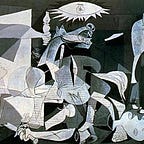Stochastic Terrorism: Rhetorical Strategies
Stochastic Terrorism is the outcome of a rhetorical strategy pejoratively called propaganda and euphemistically called “public relations.” Individuals and Groups holding a public platform, or employing media professionals, propagate violent, dehumanizing rhetoric over mass media with a few standard characteristics: an “authority,” a target-audience, and a violence-target.
“Stochastic Terrorism has statistically predicable outcomes that reflect purposeful choices by the media producer.”
Stochastic Terrorism follows consistent rhetorical patterns of “introduction,” “body,” and “conclusion.”
Introduction:
1. The narrator will frame/fabricate a rhetorical conflict.
Body:
2. The backgrounded narrator will have or establish a sympathetic stance with a target-audience (the audience called upon to do violence).
3. The narrator will cast a dehumanized, antagonist (violence-target, out-group) as violent perpetrator, victimizing a supra-humanize a sympathetic protagonist/Christ-figure, (as idealized representative of target-audience/in-group).
Conclusion: 2 Types
4a. Unresolved. The overall effect is to create a feeling of existence/identity threat with “no solution” for the audience. The rhetorical conflict creates cognitive dissonance in the audience, pitting their positive (pro-social) perception of “self” against the necessity of violent resolution. To resolve this conflict, the target-audience might engage in what they feel to be justified “reciprocal” violence against the designated violence-target.
4b. Resolved. In this case the “authority” justifies their “necessary violent action” as having “no alternative.” Examples of this form appear in District Attorneys’ statement asserting “justified use of force,” and many other statements, written by authorities, asserting the necessity of authoritarian violence. This is psychological violence against the violence-target.
“Stochastic Terrorism is a purposeful outcome of a rhetorical strategy toward disruptive and dominating violence in psychological warfare.”
From the position of the “in-group” it is difficult to recognize that we are immersed in psychological warfare, continually constructed, reiterated, and reenforced by our leadership and the vast majority of our media sources, including so-called “liberal media,” and entertainment. Unless we are paid to engage in violence, we are effectively controlled through our complicity, which creates a cognitive dissonance that finds a willing, but temporary, resolution in the acceptance of the dominant narrative. The dominant narrative is one of “division” and the “no alternative” of violent dominance.
This psychological warfare is apparent from the position of the out-group, and felt to be ubiquitous. That the out-group experiences both the intimidation of stochastic terrorism and the predictable, consistent, and statistically relevant physical violence and loss of life associated with stochastic terrorism tells us both that it exists and that it is being willfully employed by leadership and media alike.
“The purpose of Stochastic Terrorism, and the physical and psychological violence it manifests, is to gain control of territory through population compliance.”
Moving forward, I’ll be looking at media examples of Stochastic Terrorism. Here is my first attempt at outlining stochastic terrorism in effect, as executed by Eugene Police Chief Chris Skinner, establishing the psychological context for vigilantism and a hate crime : https://www.youtube.com/watch?v=m1R4eGnfmIg
I encourage readers to analyze for themselves the consistent rhetorical patterns of Stochastic Terrorism.
